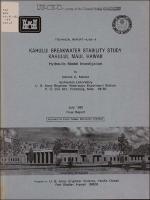Please use this identifier to cite or link to this item:
https://hdl.handle.net/11681/13431Full metadata record
| DC Field | Value | Language |
|---|---|---|
| dc.contributor | United States. Army. Corps of Engineers. Pacific Ocean Division | - |
| dc.contributor.author | Markle, Dennis G. | - |
| dc.date.accessioned | 2016-07-18T15:33:14Z | - |
| dc.date.available | 2016-07-18T15:33:14Z | - |
| dc.date.issued | 1982-07 | - |
| dc.identifier.uri | http://hdl.handle.net/11681/13431 | - |
| dc.description | Technical Report | - |
| dc.description | Abstract: A hydraulic model investigation was conducted at geometrically undistorted, linear scales of 1:33, 1:36, and 1:40, model to prototype, to evaluate the stability against wave attack of proposed rehabilitation designs for two areas, each on the harbor sides of the east and west breakwaters at Kahului Harbor, Maui, Hawaii. A proposed rehabilitation design for the sea-side slope of the west breakwater at sta 18+50 and the existing sea-side slope protection on the west breakwater at sta 21+25 also were evaluated for stability against wave attack. Where the proposed designs failed, additional tests of alternative plans were conducted until stable design sections were found. All plans were tested for the worst breaking wave conditions that could be produced for the selected wave periods, water depths, and bathymetry seaward of the test sections. The existing 19-ton tribars on the sea-side slope of the west breakwater at sta 21+25 proved to be stable, and six plans (three dolos and three tribar) were found acceptable for the proposed harbor-side slope rehabilitation. With the addition of a concrete rib cap on the crown of the west breakwater at sta 18+50, 11-ton and 5-ton tribars were found to be stable on the sea- and harbor-side slopes, respectively. For the east breakwater at sta 26+10, 9-ton tribars showed very good stability when placed on a 1V-on-2H harbor-side slope. A concrete rib cap was added to stabilize the crown and upper sea-side slope of the east breakwater at sta 23+35 and 9-ton tribars placed on a 1V-on-2H slope provided stable protection for the harbor-side slope. The stabilities of all plans found acceptable are dependent upon trenching and/or special placements of the toe armor units, as described for each alternative design. Model observations also indicated that the harborside armor unit protection should not extend above the breakwater crown elevation any more than absolutely necessary. Tests indicated that it was preferable to leave a small gap between the concrete rib cap and the upper harbor-side armor protection than to fit a unit in this area if a large portion of the unit had to project above the crown of the structure. | - |
| dc.publisher | Hydraulics Laboratory (U.S.) | - |
| dc.publisher | Engineer Research and Development Center (U.S.) | - |
| dc.relation | http://acwc.sdp.sirsi.net/client/en_US/search/asset/1033400 | - |
| dc.relation.ispartofseries | Technical report (U.S. Army Engineer Waterways Experiment Station) ; HL-82-14. | - |
| dc.rights | Approved for public release; distribution is unlimited. | - |
| dc.source | This Digital Resource was created from scans of the Print Resource | - |
| dc.subject | Armor units | - |
| dc.subject | Stone armor | - |
| dc.subject | Breakwaters | - |
| dc.subject | Harbors | - |
| dc.subject | Hydraulic models | - |
| dc.subject | Waves | - |
| dc.subject | Wave action | - |
| dc.subject | Kahului (Hawaii) | - |
| dc.subject | Maui | - |
| dc.subject | Breakwater stability | - |
| dc.title | Kahului breakwater stability study, Kahului, Maui, Hawai : hydraulic model investigation | - |
| dc.type | Report | en_US |
| Appears in Collections: | Technical Report | |
Files in This Item:
| File | Description | Size | Format | |
|---|---|---|---|---|
| TR-HL-82-14.pdf | 15.57 MB | Adobe PDF |  View/Open |